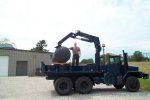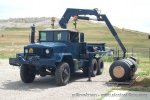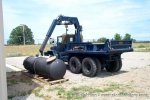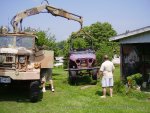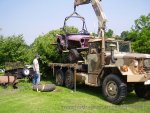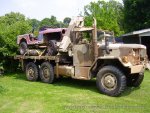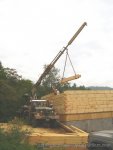miltruckman
Member
- 200
- 2
- 18
- Location
- Lebanon, Indiana
Lance ask me to post about mounting a knuckleboom crane. So I'll write a little on the subject.
HI Lance, or anyone interested,
What I did to mount a knuckleboom crane:
My truck was originally a M49 which happens to be a standard length M35 truck.
I removed the M49 fuel tank from the rear and located the bed from an M342A2 dump truck. This bed is shorter than a standard cargo truck bed. This left me with ~2 ft of space between the front of the bed and the back of the cab. Instead of mounting the tool box and spare tire in this space as is done on the M342's, I removed the cab shield from the dump bed and mounted the crane from an Alvis Stalwart. That is a British military truck. It is used for loading ammunition. Most knucklebom cranes for this class of truck take up about 2ft of frame length, so this method of swapping beds should work.
Other difficulties I encountered were:
The crane legs ended up right where the truck fuel tank and spare tire were mounted. I solved this problem by using a set of smaller diameter tanks from an M275 tractor truck and shortening them to fit in the space available. I now have a 35 gallon tank on each side.
The rear frame cross member on the M342 is also mounted forward to allow clearance for the hitch. Otherwise the pintle hitch will be bent down when the truck bed dumps (don't ask me how I know this!) I solved this by reversing the rear cross member channel and remounting the pintle hitch inside the channel. There is also a rear cross member angle brace I had to move forward a few inches to match the new cross member position.
The dump bed hydraulic pump is mounded between the frame rails behind the transfer case and powered by the rear facing PTO adapter mounted on the transmission PTO.
The crane is powered by the rear facing PTO on the transfer case. This attachment is standard on the fuel tanker truck so I already had the linkage to operate it.
another difficulty is the dump bed PTO lever and transfer case PTO lever are both mounted on the left of the drivers seat using the same linkage shaft mounted across the floor of the cab behind the drivers seat. I solved this problem by exchanging the solid shaft behind the drivers seat with a tube exactly the same size. Then I ran a shaft through the tube allowing the attachment of the original linkage end and lever on the outside of the tube and the extra set of linkage end & lever on the ends of the smaller inside shaft. This way both PTO control levers fit nicely to the left of the drivers seat.
Another little known fact is; If the transfer case has a PTO, you should never leave the transfer case in neutral and the transmission in gear (unless the transfer case PTO is also engaged) or the upper bearings in the transfer case will not be adequately lubricated.
I'll attach a couple of photos of the crane in action. I took the truck to work to unload a large silencer (muffler) for the caterpillar engines I run at the power plant. They delivered it in a box truck and I had to reach in and pick it up, then the truck driver drove out from under it. It was so long there was no way to unload it with a forklift.
Bill
Michigan
HI Lance, or anyone interested,
What I did to mount a knuckleboom crane:
My truck was originally a M49 which happens to be a standard length M35 truck.
I removed the M49 fuel tank from the rear and located the bed from an M342A2 dump truck. This bed is shorter than a standard cargo truck bed. This left me with ~2 ft of space between the front of the bed and the back of the cab. Instead of mounting the tool box and spare tire in this space as is done on the M342's, I removed the cab shield from the dump bed and mounted the crane from an Alvis Stalwart. That is a British military truck. It is used for loading ammunition. Most knucklebom cranes for this class of truck take up about 2ft of frame length, so this method of swapping beds should work.
Other difficulties I encountered were:
The crane legs ended up right where the truck fuel tank and spare tire were mounted. I solved this problem by using a set of smaller diameter tanks from an M275 tractor truck and shortening them to fit in the space available. I now have a 35 gallon tank on each side.
The rear frame cross member on the M342 is also mounted forward to allow clearance for the hitch. Otherwise the pintle hitch will be bent down when the truck bed dumps (don't ask me how I know this!) I solved this by reversing the rear cross member channel and remounting the pintle hitch inside the channel. There is also a rear cross member angle brace I had to move forward a few inches to match the new cross member position.
The dump bed hydraulic pump is mounded between the frame rails behind the transfer case and powered by the rear facing PTO adapter mounted on the transmission PTO.
The crane is powered by the rear facing PTO on the transfer case. This attachment is standard on the fuel tanker truck so I already had the linkage to operate it.
another difficulty is the dump bed PTO lever and transfer case PTO lever are both mounted on the left of the drivers seat using the same linkage shaft mounted across the floor of the cab behind the drivers seat. I solved this problem by exchanging the solid shaft behind the drivers seat with a tube exactly the same size. Then I ran a shaft through the tube allowing the attachment of the original linkage end and lever on the outside of the tube and the extra set of linkage end & lever on the ends of the smaller inside shaft. This way both PTO control levers fit nicely to the left of the drivers seat.
Another little known fact is; If the transfer case has a PTO, you should never leave the transfer case in neutral and the transmission in gear (unless the transfer case PTO is also engaged) or the upper bearings in the transfer case will not be adequately lubricated.
I'll attach a couple of photos of the crane in action. I took the truck to work to unload a large silencer (muffler) for the caterpillar engines I run at the power plant. They delivered it in a box truck and I had to reach in and pick it up, then the truck driver drove out from under it. It was so long there was no way to unload it with a forklift.
Bill
Michigan
Attachments
-
57.5 KB Views: 914
-
86.1 KB Views: 907
-
87.1 KB Views: 910



